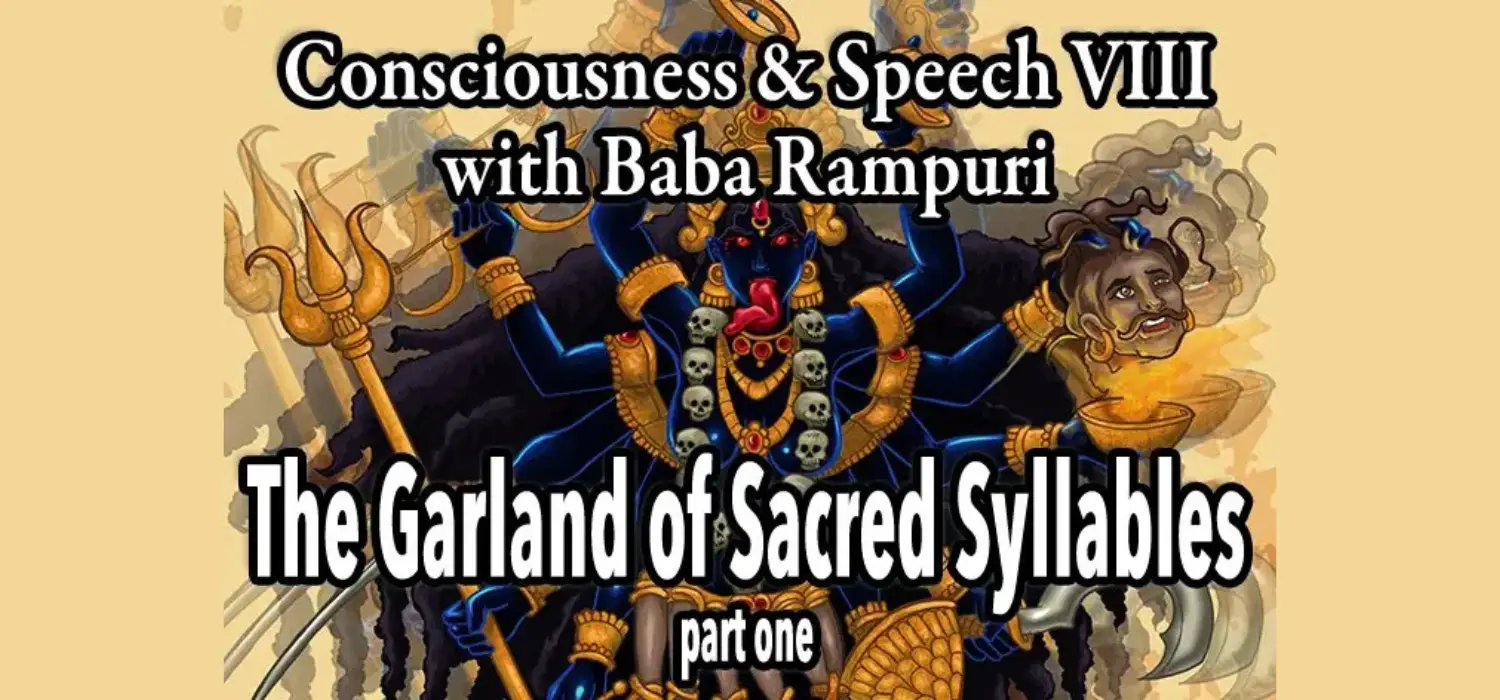
Garland of Sacred Syllables, VIII, part 1
Sacred Speech Masterclass episode VIII
part 1 of 6 parts
hosted by Baba Rampuri
![]()
The Garland of Skulls
The Garland of Sacred Syllables, like that of severed skulls, adorns the neck of the Great Goddess.
![]()

![]()
This is the Sanskrit English dictionary that is used by just about everyone in the English language world, and in some of the other languages as well. As it’s a big dictionary, the best one that I know of in English. There are some in German that I think are perhaps better. But what I wanted to do is read you this short paragraph in the preface of the new edition, which was written in 1899 at Oxford University in England.
Ok. This is on page Roman numeral IX in the preface of the “new” edition. And he writes:
“In explanation, I must draw attention to the fact that I am only the second occupant of the Bowden Chair of Sanskrit and that its founder, Colonel Bowden stated most explicitly in his will, dated August 15, 1811, that the special object of his munificent bequest was to promote the translation of the scriptures into Sanskrit, so as to “enable his countrymen to proceed in the conversion of the natives of India to the Christian religion.”
This is the dictionary. This is what we have learned to treat as the authority for words. When translators might translate Patanjali, they will look up in the dictionary for a particular word, and they’ll see a number of options before them, and they will choose among options according to what fits the sentence that they are writing in terms of their meaning, in terms of the sound of the sentence, in terms of the way that they like a particular word. And, as we can see, that that authority is misplaced within the confines of an Oral Tradition. And this is very much what we are dealing with in our conversation about Sacred Speech.
The work of Panini in his Ashtadhyayi — last week we went over the Mahesvara sutra—and we could see how out of a relatively small phonetic system, a entire language is manifested. In Panini’s Ashtadhyayi there are 4000 sutras. Out of these 4000 sutras, not only is the entire Sanskrit language manifested, but starting in the 20th Century in Europe and America, a certain mathematicians became interested in they connection between language, speech and mathematics, and, in fact by 1940 there was a mathematician by the name of Emil Post, who very much influenced by Panini, he to … he wrote about that, as well as another mathematician, Turing, they saw that in the formal system of Panini which proceeded formal systems of logic in Europe by perhaps 2500 years that there was a direct connection with mathematics. Emil Post went a step further. And he took one of the basic attributes of Panini’s sutra system and he devised a theory that is usually referred to as, what’s it called, oh, I forget the name, symbolic, auxiliary symbols. And it is with this system of auxiliary symbols that the modern computer languages are all based. This was the key for the modern computer languages … was a means of endlessly generating speech which is one of the genius elements of Panini’s composition. So we’re seeing here something that is actually beyond, quote unquote, “religious observances.” It is beyond an ideology or a religion.
Fritz Staal, the eminent Dutch Sanskritist probably among the Western Sanskritists of the 20th Century, besides studying Panini as the great grammarian and the master of grammar, he called Panini India’s Euclid. There is a connect between the geometry of sacrificial fire pits, of sacrificial altars and in fact the entire set up of any Vedic ritual, which relates also directly to the mathematics implied as a formal system in the language, in the speech of Vedic ritual, Vedic sacrifice.
So, here we have an area that the greatest minds in the history of the world, Panini, Patanjali, Pythagoras in Greece and Sicily, saw the connection between speech, mathematics and music. Aristotle took off with the Pythagorean theories. And once Panini’s composition reached the Europeans in the end of the 18th, beginning of the 19th century, the reading of Panini is responsible almost single handedly for the study, the modern study of speech and the cognitive sciences, including linguistics. So this is, this is the area that we’re dealing with. I find it especially curious that several of the mathematicians that have used the composition of Panini to develop their mathematical theories have pointed out the necessity that Panini’s composition is part of an oral tradition and is an oral composition. This I believe would also connect with Noam Chomsky’s theories of cognition and speech in which Chomsky claims that the language is not really learned by the child from the parent, but inherent in the DNA of the child from birth.
This has a correspondence with Bhartrihari’s exposition on speech in Vākyapadīya, where he describes speech as also being inherent in the newborn infant however not referring to DNA but referring to previous births, incarnations, rebirth. So I wanted to give you that little background to this huge subject that we are dealing with here and to reassure you that if you are having any difficulties in understanding how I am trying to take you into this speech it’s very normal. We’re having a conversation about one of the most difficult subjects that I know of.